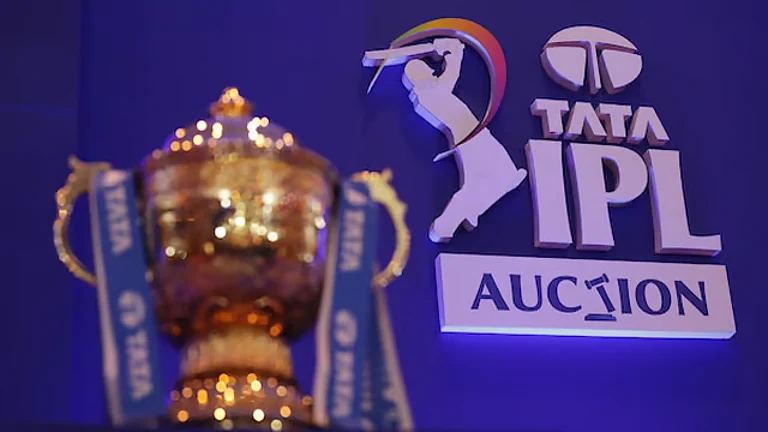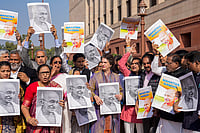SAHITYA Sahawas is a block of colourless flats in the Bombay suburb of Bandra. Situated bang behind the Tiger's lair where the crucial but unofficial, and therefore illegal, decisions on India's cricketing engagements with Pakistan are made, it houses some of the city's top writers and journalists. But not even the best of them could have scripted The Life and Amazing Times of Sachin Ramesh Tendulkar.
Man of the Match in two of India's first three outings in the Wills World Cup—and very nearly Man of the Match in the third one too—the 22-year-old has become the lodestar on whom the hopes of his team of 11 and a nation of 900 million rest: of going to Lahore and holding aloft the Cup. And after India's chances of beating Australia in Bombay were stumped when Sachin rushed out to meet a wide one from Mark Waugh, a single thought must have crossed a million minds: is India doomed to sink whenever he stops swimming?
"This man Tendulkar may be getting all the publicity, but don't forget, the others are also crucial to India's success," Caribbean speed merchant Michael Holding has been saying on air. But as the legendary off spinner of yesteryear, E.A.S. Prasanna points out: "At the moment, the way the rest of the team is playing, the feeling is probably justified. Sachin is just too, too, too talented for someone so young. It may be no fault of his, but what his brilliance is doing is separating the average in the side from the out of the world."
And it's a perception widely shared by India's rivals. Says Sri Lankan skipper Arjuna Ranatunga: "Getting Sachin out is like half the battle won against India." For his part, Sachin makes light weather of the heavy burden he carries: "Victory or defeat, there are 10 other responsible men like me. It's unfair to them and unfair to me to leave them out."
After Tendulkar's 90 of 84 deliveries against Australia at the Wankhede Stadium in Bombay on February 27 last, Michael Henderson of The Times went into raptures. "Think of Olivier at the old Vic. That is how Tendulkar stands in regard to this ground," he wrote. He can almost smell the audience,Henderson suggested, adding that his sensational stroke play had "Bombay, all of India... drunk with delight."
Cricket writer Raju Bharatan hazards a reason for all the hype about the one-man army: "The media is always looking for heroes. First it was Brian Lara, now it's Sachin Tendulkar. Only the Australians have been able to establish some semblance of balance without seeming to depend on any one single player to work all their miracles. That's the way it should be."
Still the question remains: Can he do it all on his own? Obviously, no. However many runs Sachin scores and howsoever fast, there are still wickets to be taken and catches to be held. And over and above that, there has to be somebody at the other end to run with him between the wickets. Says former Test cricketer Ashok Mankad: "Can you imagine Shah Rukh Khan in Dilwale Dulhaniya Le Jayenge without the rest of the cast? No. Socan't you imagine Sachin without the other 10. They're the supporting actors, he's the hero. He may get the Oscar, but without them it would be impossible."
To be sure, this isn't the first time Indian cricket has placed all its eggs in a small basket. But fanatics talk less of Sunil Gavaskar's superlative 1971 West Indies debut not because of lack of gratitude or a fading memory, but because the Little Master wasn't alone, there were others complementing him. Sachin, however, has seemed more like the lone boy on the burning deck trying to steer INS India ashore.
And the manner in which he has done so—at least so far—is also what sets him apart from Gavaskar's heroic effort. Not for him the studied defence that the cramped gullies and colonies of Bombay inculcate in every budding batsman. Or those textbooks drives behind the bowler on either side of the wicket and those delicate nudges square of the wicket. Says former India opener K. Srikkanth: "He makes batting look very simple. Only Vivian Richards batted simpler."
Probably because he grew up in the relatively spacious Sahitya Sahawas residence of his writer-father, where there was less of a danger of inviting the neighbours' wrath for breaking glasspanes, and probably because there were no fears of hitting the ball out of the colony, the pull and the loft respectively became the most potent weapons in Sachin's large armoury.
He is a product of the times. He's as different as anybody can get from the archetypal Bombay batsmen. With him it's not a need to survive at the wicket and eke out an innings. Sachin's strength stems from brute power generated by a pronounced bottom hand grip transferred to a three-pound bat, the heaviest in the business. "On his day Sachin can butcher any attack if he can keep his concentration," says Gundappa Viswanath, chairman of the national selectors.
That, and an astounding ability to improvise. In the match against Australia, when Mark Taylor positioned a man at midwicket to halt the run riot, Tendulkar pulled paceman Glenn McGrath straight to the sight screen, much like Don Bradman played a tennis-style smash shot to avoid falling into Harold Larwood's leg trap in the Bodyline series. If there was a half-chance, it stayed just that.
Says Manoj Prabhakar: "Sachin is the only batsman I have seen who can offer two, sometimes three, shots for any ball bowled at him—on either side of the wicket." Adds schoolmate Vinod Kambli, whose aside on Sachin taking the escalator to superstardom while he took the stairs has entered cricket lore: "He can pick up a ball from offstump and thump it over squareleg. How many can?"
Not many. But if his belligerence is intimidating Sachin's colleagues, they aren't saying so. Skipper Azharuddin doesn't mind Sachin calling the shots at training camps or giving advice on field placing or bowling changes when the going gets tough. "He's taken a lot of pressure off me," says the captain who made his Test debut at the time Sachin went to the nets 11 years ago.
Nothing seems to faze him. Not pace. In his debut series in Pakistan in 1989, when pace pashas Wasim Akram and Waqar Younis hurled their combined fury at him, there were oohs and aahs of concern when a bouncer felled the 16-year-old. But Tendulkar recovered his poise, waved away medical attention, and took the battle into the enemy camp with a four off the next ball.
Not pressure. When Azhar seemed to be at his wit's end on how to prevent South Africa from scoring six runs of the final over in the 1993 Hero Cup, Sachin grabbed the ball and bowled one-day cricket's six most historic balls. India won with some to spare.
Not spin. When Abdul Qadir wove a web around the youngster in an exhibition match on the same tour, Sachin watched a while before breaking free and hoisting the leg spin maestro repeatedly over the ropes. Don Bradman hit just 46 sixes in first-class cricket, and that too late in the innings when the team's interests demanded them. Sachin is not averse to lofting the ball early on.
Not even sledging. After he had scored tonnes of runs against the West Indies on easy-paced pitches at the start of their 1994 tour, Kenneth Benjamin dug one short in the first Test in Bombay, went up to him and said: "The one-day series is over. This is the real stuff." When Benjamin tried the same in the second Test, Sachin got up to hip height, pushed it back for four, walked over to the bowler and retorted: "This isn't Bombay."
Does this quiet but assertive confidence for one so young, for a man so small, rattle his teammates? "The rest of the batting can be quite brilliant but seldom so once Tendulkar has failed," writes journalist Scyld Berry of The Sunday Telegraph, London. Three years ago, at the Khetterama stadium in Colombo, India, just 20 runs short of a modest Sri Lankan total, collapsed after Sachin was run out going for a suicidal second run.
KAMBLI disagrees: "On the contrary, we admire the way he plays and carries himself." But former Bombay opener Zubin Bharucha, who's played alongside Sachin, echoes Dilip Vengsarkar's sentiments that the team seems to be in trouble if Sachin exits early. "Sachin's success stems from his extreme confidence in himself and his abilities. There you are nudging and pushing for singles and twos, and here he comes lofting and pulling for sixes and fours. It makes us ask ourselves some pretty uncomfortable questions," he says.
So long as he doesn't expect everybody to do the same, there might be no problem, but Sachin's peers say he has the tendency to expect everybody to live up to his standards. "Naturally not many can," says one.
"At the nets, he bats for hours, bowls nonstop after that, and has fielding and catching practice in the end. You can't even begin to explain his enthusiasm for the game, forget competing against it."
Eyewitnesses recall seeing a lot of it five years ago in Bangalore where the Indian team was at a conditioning camp prior to the England tour. Almost everyday after nets had been packed up, when the seniors rested, Sachin would turn up before cricket manager Bishen Singh Bedi and ask, in a child like manner: "Sir, kya hum jaake khel sakte hain?" Hangers-on got to bowl at the genius-in-waiting. Tendulkar, then 17, went on to knock up his first century in Tests on a pitch turning like a top against 42-year-old offspin wizard Eddie Hemmings.
Former Test offspinner Shivlal Yadav believes that the increasingly larger role Tendulkar has begun to play in determining India's fortunes may be all for the team's good. He says: "Cricket all said and done is a game of 11 players. At the moment Sachin is in the dominant role because he has chosen to open the innings. If he continues like this, it'll help boost the morale of the others."
Sachin volunteered to open the innings in one-day internationals—he still prefers to go two down in the Tests—after having played 70 matches. He has since made all his five centuries in instant cricket in that role and only once batted lower down the order. "My job is just to give a great start, so that the others can think of dominating, not surviving the attack," he says wisely.
It's the kind of attitude that pleases the pundits no end. Says Mankad: "He opted to open the innings although such a move could have jeopardised his career. And having done that, he has shown a consistently positive attitude of going about it. Those are just the two ingredients required for a cricketer's success. "
Sachin's recipe has worked, but Brian Lara's 375 and 501 have made comparisons inevitable. "I'm sick, sick, sick of being asked who's better, Lara or Tendulkar although they are the only batsmen I buy a ticket to watch," says Sir Garfield Sobers.
But those who know the tiny Indian well insist it's a no-contest with the Caribbean King. Says a close friend: "For all his feats, Lara ended up a mental wreck at the end of it. Tendlya, on the other hand, has handled the pressures—and the pleasures—better."
Six years after his debut, the expectations of fans and colleagues from India's preeminent batsman are only growing. But as Australian legend Greg Chappell told Sportstar editor N. Ram: "I hope not too many people place too much pressure on him. He's a human being, a very talented human being, he's going to have a few frailties, he's going to make some mistakes, he's going to have some failure. Accept that and enjoy the good things he's going to do but don't punish him for any failures he might have and don't expect too much of him." The only problem is, the whole of India is resting its hopes on him.






















